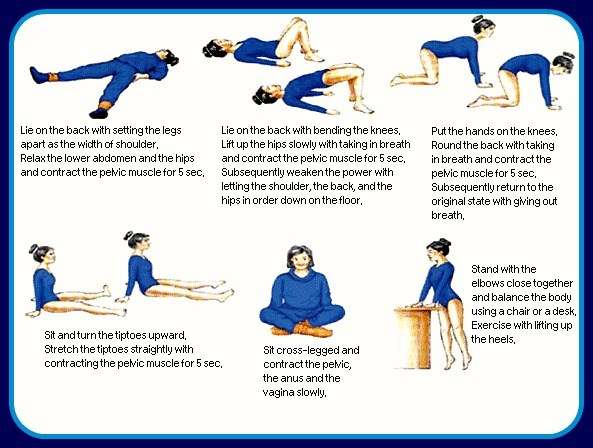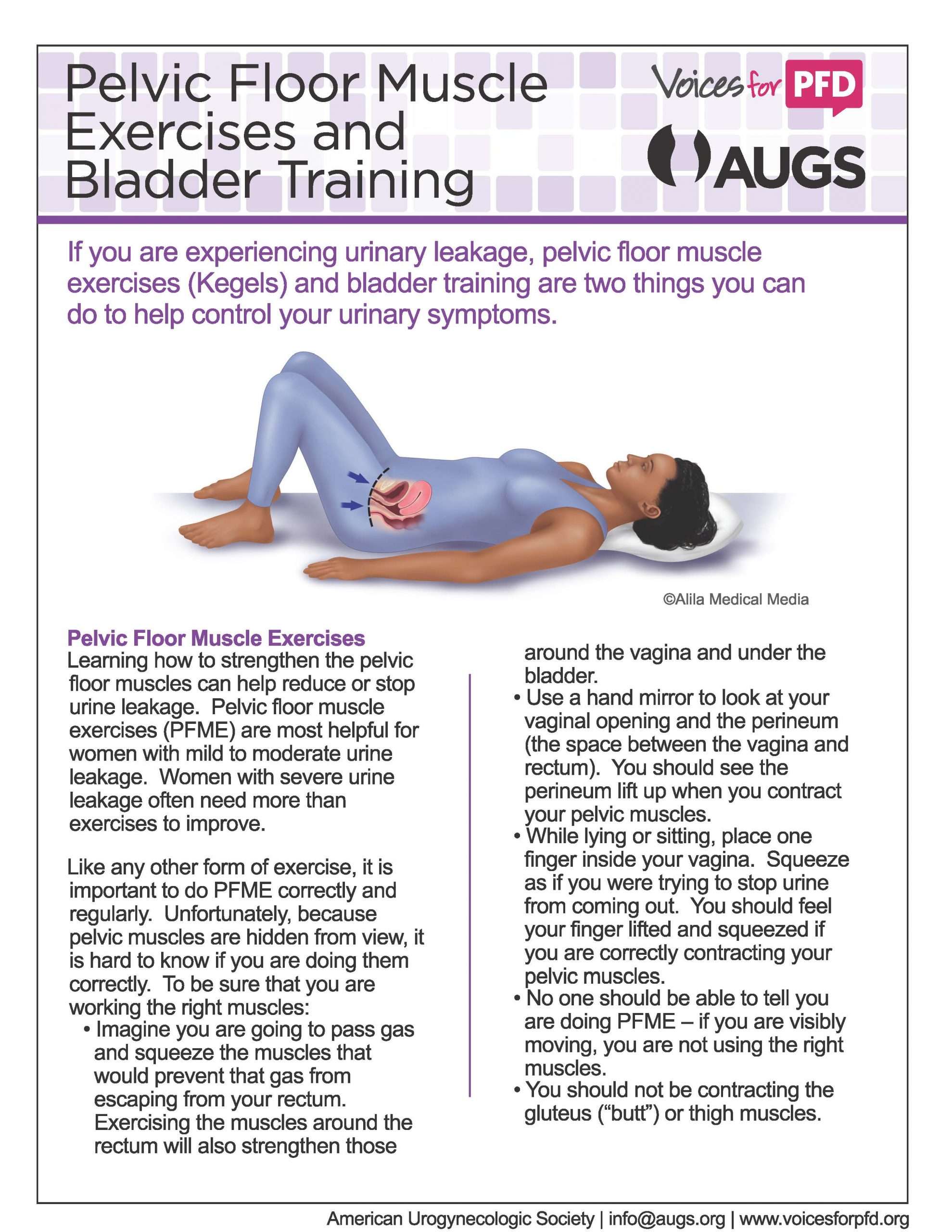Tighten Your Pelvic Floor With Kegel Exercises
Kegels, or pelvic floor muscle exercises, can benefit both men and women who have urinary incontinence by strengthening the muscles that support the bladder. This, in turn, helps prevent urine leaks and the feeling of urgency that comes with overactive bladder. And Kegels couldnt be easier to do: Per the National Institute of Diabetes and Digestive and Kidney Diseases, simply squeeze or tighten your pelvic floor muscles these are the same muscles you use to stop the flow of urine or passing gas for a count of three and then slowly relax them for a count of three. Kegels are so easy, you can do them anytime even while sitting in your car at a stoplight or at your desk at work. Build up to doing one set of 10 to 15 squeezes, three times a day, and your bladder control should improve within six weeks.
Getting The Technique Right
This is the most important part of the pelvic floor muscle exercises as there is no point doing them if you are not doing them correctly.
Imagine letting go like you would to pass urine or to pass wind. Let your tummy muscles hang loose too. See if you can squeeze in and hold the muscles inside the pelvis while you breathe. Nothing above the belly button should tighten or tense. Some tensing and flattening of the lower part of the tummy wall will happen. This is not a problem, as this part of the tummy works together with the pelvic floor muscles.
Try tightening your muscles really gently to feel just the pelvic floor muscles lifting and squeezing in. If you cannot feel your muscles contracting, change your position and try again. For example, if you cannot feel your muscles contracting in a seated position, try lying down or standing up instead.
After a contraction it is important to relax the muscles. This will allow your muscles to recover from the previous contraction and prepare for the next contraction.
It is common to try too hard and have too many outside muscles tighten. This is an internal exercise and correct technique is vital. Doing pelvic floor muscle exercises the wrong way can be bad for you, so please see a health professional if you cannot feel your muscles hold or relax.
Find Your Pelvic Floor Muscles
Overactive bladder is one common cause of bladder control problems, especially among women. Doing regular Kegel exercises can help treat this condition. These exercises also called pelvic floor muscle exercises.
Kegel exercises are relatively easy to do. But before you can start, you need to find your pelvic floor muscles. The next time you urinate, try to stop your flow of urine midstream. The muscles you use to do that are your pelvic floor muscles.
Recommended Reading: What Are The Chances Of Surviving Bladder Cancer
The Link Between Weak Bladder And Oab
When the smooth muscle within the bladder becomes overactive, it can lead to improper contraction and relaxation of the muscle. Problems in the nerves that stimulate the bladder, as well as some neurological conditions, may lead to OAB.
According to the Urology Care Foundation, as many as 30% of men and 40% of women in the United States have OAB symptoms.
The muscles in the lower abdomen that support the bladder and urethra are known as the pelvic muscles. For women, these muscles often stretch and weaken during pregnancy and childbirth, which can cause organs in the abdomen to shift.
A lack of muscle support around the bladder can cause sagging, which can lead to leakage. This can lead to stress incontinence, which often results from a mix of OAB and urge incontinence.
If a person is experiencing frequent urination or having urine leakage after a sudden urge to urinate, it may be time to talk with a doctor about treatment options to help with OAB.
However, there are also several lifestyle changes that a person can make to help to calm the bladder muscle, which may help improve OAB symptoms. Read on to learn more.
The sections below provide suggestions for ways to help manage a weak bladder, which may also improve OAB symptoms.
Who Could Benefit From Pelvic Floor Exercises

People who have faecal incontinence or bowel leakage may be helped by doing some specific exercises for the sphincter and pelvic floor muscles. These exercises could help improve the strength of the sphincter and pelvic floor muscles and improve bowel control. Talk to your healthcare professional before doing these exercises to see whether they could help you.
Pelvic Floor Exercises can help both men and women gain more control over bowel movements. These exercises are also used for men and women with bladder control problems.
Recommended Reading: How To Diagnose Bladder Infection
What Medications Can I Use For Overactive Bladder
Your doctor may suggest trying behavioral techniques before having you use a medication to treat overactive bladder. However, medications can work very well to return normal function to the bladder. Ask your doctor about the risks and benefits of using the following commonly prescribed medications:
Anticholinergic medications
These medications control muscle spasms in the bladder:
- Oxybutynin , oxybutynin XL , oxybutynin TDDS .
- Tolterodine .
- Mirabegron .
Pelvic Floor Muscles That Are Too Tight
A hypertonic pelvic floor occurs when the muscles in the pelvic floor become tense and unable to relax. Many people who have a tense pelvic floor may experience constipation, painful sex, urgency and pelvic pain.
A women’s, men’s and pelvic health physiotherapist can help you manage or treat your hypertonic pelvic floor.
You May Like: Start Of Bladder Infection What To Do
Strengthening Your Pelvic Floor Muscles
Millions who suffer with urinary incontinence feel like their bladder controls their lives. Control depends on muscles working together. This simple step can control your bladder!
National Institute of Diabetes and Digestive and Kidney Diseases, National Institutes of Health
When the bladder fills, the bladder muscles should be relaxed and the muscles around the urethra , called the pelvic floor muscles, should be tight. Exercises that strengthen these muscles can help prevent leakage and calm the urge to go. These are commonly called “Kegel” exercises, named after the doctor who developed them. They can help keep your pelvic floor muscles toned and may reduce your problems with leakage or frequent urges to urinate.
How Long Should You Continue With These Exercises
Like any group of muscles, it is in your own interest to keep them in good shape so really everyone should be exercising their pelvic floor muscles from childhood through to old age.
If you already have some symptoms that might be caused by a weakened pelvic floor, do not be disappointed if you do not notice any improvement even after a month or two of exercising it is a long process, which needs patience and some willpower. It may help to talk to a specialist continence adviser or a continence physiotherapist about the exercises to make sure you are doing them properly. They may also be able to suggest additional exercises, exercise devices or muscle stimulation which could speed up the process.
Also Check: Shortness Of Breath And Loss Of Bladder Control
There’s No Reason You Have To Live With The Embarrassing Inconvenience Of A Leaky Bladder
Dealing with urinary incontinence bladder leakage that you can’t control? Youre not alone. Bladder control problems affect millions of men and women of all ages, with many of them suffering in silence because they feel too shy, awkward, or downright embarrassed to talk about it with friends, family, and even their doctors. Truth is, theres a lot you can do to decrease your risk of urinary incontinence episodes and avoid accidental leaks.
Support And Information About Sexual Health And Intimacy
If you need more support or information about sexual health or intimacy, you can also talk with your healthcare provider about MSKs Female Sexual Medicine & Womens Health Program. For more information or to make an appointment, call .
The Female Sexual Medicine & Womens Health Program provides services at the following locations:
- Rockefeller Outpatient Pavilion
- Evelyn H. Lauder Breast Center300 East 66th Street
Don’t Miss: How To Find Out If You Have Bladder Cancer
How To Delay Hunger
You may associate urinary incontinence with aging, but an overactive bladder can also affect younger people. Women who have just given birth are particularly at risk for loss of bladder control. Urinary incontinence symptoms include leaking a small amount of urine when you are laughing or coughing and having a strong need to urinate that is difficult to control. Although no foods specifically help to strengthen the bladder, avoid certain foods that can irritate this organ.
Can Kegels Improve Sex

Kegels improve blood circulation to the pelvic floor and vagina, and this may be helpful for arousal and lubrication. A lot of women, after childbirth, feel like their vagina is not as tight as it was before and they want to have surgery for that. But strengthening the pelvic floor muscles with kegel exercises can make it a little bit more taut. It might be tighter because women are better able to contract their muscles, and that might improve sensation. Even if its psychological, it can help women feel better about their pelvic floor, so theres a positive benefit.
Don’t Miss: Does Hair Dye Cause Bladder Cancer
Can Overactive Bladder Be Controlled
Overactive bladder therapy can be challenging to manage. However, many people are very satisfied with the treatment they receive and they often see a dramatic improvement in their quality of life. Your doctor will guide you to the best steps to begin with and give you options for any additional treatments you may need over time.
Exercises Your Leaky Bladder Wants You To Do
There are exercises for your butt, your legs, your arms, your spare tire, even your ever-texting achy thumbs. So considering the bladder itself is a muscleand it’s surrounded by other musclesit makes sense that you can whip that puppy into shape, too.
Of course, unless you already have the occasional leakage due to aging, genetics, or childbirth, you might not focus much exercise attention on your bladder. But strengthening those down-there muscles can stop so-called stress incontinence in its tracks, says Candace Howe, MD, a board-certified ob-gyn in private practice in Newport Beach, California. “Who wants to undergo surgery?” Howe says. “I’m a surgeon, and I tell my patients I wouldn’t want to! If we can fix incontinence with exercise, that’s preferable.”
When Suzanne Andrews, host of Functional Fitness, was experiencing urinary incontinence after the birth of her son, her doctor told her to consider surgery. As an occupational therapy clinician, Suzanne was seeing patients with the same symptoms and realized her exercise background could help. She created the 30 Day Bladder Fix, a pelvic floor strengthening DVD that combines seated and lying-down exercises to help control incontinence. “I remember the day I realized I didn’t have it anymore,” Andrews says. “I sneezed and nothing came out!”
Don’t Miss: Is Cranberry Juice Good For Overactive Bladder
Exercises To Help Prevent Bladder Incontinence
Kegel exercises are one type of workout you can do anywhere, anytime. When youâre doing Kegel exercises properly, they are invisible to others. The most important thing to understand is that Kegel exercises only involve the pelvic muscles, not the stomach or chest muscles. You should feel like youâre clenching up and in, not pushing down and out like a bowel movement.
Finding Your Kegel Muscles
The first step to properly exercising your pelvic muscles is to feel them in your body.
Step 1: While sitting down or standing up, feel the sensation of urinating.
Step 2: Imagine the sensation of stopping your urine stream before your bladder is empty.
Step 3: Notice which muscles tense when you imagine this sensation. These are your pelvic muscles. The way they tensed in this exercise is the beginning of most Kegel exercises.
Note: donât actually do this when urinating. Regularly stopping your urine before your bladder is empty can damage your bladder and even result in bladder infections. If this exercise isnât helpful, you can also imagine the sensation of avoiding passing gas or squeezing a tampon if you have a vagina.
Sitting Fast-Twitch Exercise
You have two important kinds of muscle tissue, known as fast-twitch and slow-twitch muscles. You have both in every part of your body, including your pelvic muscles. Fast-twitch muscles react quickly, and can help you avoid stress incontinence such as a urine leak while laughing.
Step 3: Release almost immediately.
Drink Plenty Of Water
Drink 6 to 8 glasses of fluid a day unless your doctor advises you otherwise.
Many people with urinary incontinence avoid drinking fluids, as they feel it causes more problems. However, limiting your fluid intake makes incontinence worse, because it reduces your bladder’s capacity.
Not drinking enough fluid can also cause constipation or make it worse.
Find out which are the healthiest drinks.
Don’t Miss: Can A Bladder Infection Heal Itself
Seeking Medical Treatment For Incontinence
Tip: Make sure to tell your doctor about any other symptoms you are having along with loss of bladder control.
Promoting General Bladder Health
Recommended Reading: Bladder Leakage Only At Night
Tips To Keep Your Bladder Healthy
People rarely talk about bladder health, but everyone is affected by it. Located in the lower abdomen, the bladder is a hollow organ, much like a balloon, that stores urine. Urine contains waste and extra fluid left over after the body takes what it needs from what we eat and drink. Each day, adults pass about a quart and a half of urine through the bladder and out of the body.
As people get older, the bladder changes. The elastic bladder tissue may toughen and become less stretchy. A less flexible bladder cannot hold as much urine as before and might make you go to the bathroom more often. The bladder wall and pelvic floor muscles may weaken, making it harder to empty the bladder fully and causing urine to leak.
While you cant control everything that affects your bladder, here are 15 steps you can take to keep it as healthy as possible:
Why Are Pelvic Floor Exercises For Women With Incontinence So Effective

Your bladder is kept in place by a number of muscles in the pelvic floor. As long as these muscles function well, you retain control of urination. However, when the muscles lose their resilience due to age, post-pregnancy or other factors, leaks can occur. Pelvic floor exercises help you counteract this and manage incontinence better.
Read Also: Bladder Infection And Back Pain